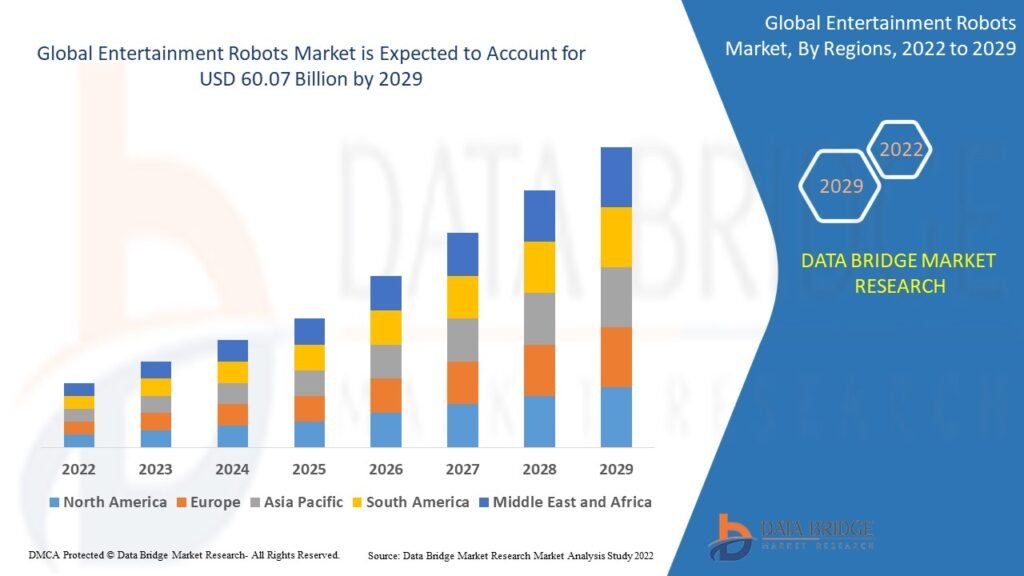Introduction
In recent years, the integration of robotics into various aspects of our lives has become increasingly prevalent. Entertainment is one field in which robotics has advanced significantly. Globally, audiences have been enthralled with entertainment robots, which range from interactive toys to highly skilled robotic performers. However, their impact extends far beyond mere amusement, touching upon realms of education, therapy, and even shaping the future of human-robot interaction.
Definition
Robots intended primarily for human amusement as opposed to any real utility are known as entertainment robots. To communicate with people, these robots are equipped with microphones for voice recognition, cameras for facial identification, and sensors. Numerous amusement activities, including dancing routines, singing, trade shows, multimedia chores, and more, can be programmed into it. It is frequently employed in the fields of cultural entertainment and story environment development.
Effects of entertainment robots on society, examining their use in learning, amusement, and other fields:
Entertainment Value
- Engaging Experiences:
This offers immersive and engaging experiences for audiences of all ages. Whether it’s a robotic pet that responds to commands or a humanoid robot performing intricate dance routines. These machines have the ability to entertain and captivate like never before.
- Novelty Factor:
The novelty of interacting with robots adds an extra layer of excitement to entertainment experiences. These machines’ unique abilities and behaviors often attract people, who actively seek out opportunities to engage with them.
- Enhanced Storytelling:
In fields like film and theme parks, this is enhancing storytelling capabilities. From animatronic characters in movies to interactive exhibits at amusement parks, robots are pushing the boundaries of traditional entertainment formats.
Educational Impact:
- STEM Education: Educators are increasingly using it as a tool to teach science, technology, engineering, and mathematics (STEM) concepts.By engaging students in hands-on activities with robots, educators can make complex subjects more accessible and enjoyable.
- Coding and Programming: Many entertainment robots that provide programmable functionalities offer users a fun and interactive way to learn coding and programming skills. This not only prepares students for future careers in technology but also fosters creativity and problem-solving abilities.
- Social and Emotional Learning: Some entertainment robots actively interact with users in emotionally intelligent ways, aiding in the development of social and emotional skills in children. These robots can serve as companions, offering support and encouragement in various learning activities.
Beyond Entertainment and Education:
- Therapeutic Applications: Entertainment robots are currently supporting individuals with special needs or mental health challenges in therapeutic settings. For instance, elderly individuals residing in care facilities have experienced comfort and companionship from robotic pets, which help reduce feelings of loneliness and isolation.
- Assistive Devices: Some robots actively assist people with daily tasks. From robotic vacuum cleaners to exoskeletons for individuals with mobility impairments, these machines are improving quality of life for people with disabilities.
- Ethical Considerations: As entertainment robots become more advanced and lifelike, ethical considerations surrounding their use continue to emerge. We must carefully consider questions about privacy, consent, and the potential for addiction to robot companionship. As these technologies become more widespread.
Challenges and Future Directions:
- Technical Limitations: Despite facing technical limitations that need addressing, entertainment robots still offer potential benefits. Issues such as battery life, mobility, and natural language processing capabilities can impact the effectiveness and usability of these machines.
- Cost and Accessibility: The cost of developing and purchasing entertainment robots can be prohibitive for some individuals and organizations. And limiting access to these technologies. Finding ways to make robots more affordable and accessible will be crucial for ensuring that everyone can benefit from their potential.
- Regulatory Frameworks: As entertainment robots become more prevalent, we need to develop regulatory frameworks to address concerns surrounding safety, privacy, and ethical use. Developing clear guidelines and standards will be crucial to ensure responsible deployment of these technologies.
Growth Rate of Entertainment Robots Market
According to Data Bridge Market Research, the entertainment robots market is projected to grow at a compound annual growth rate (CAGR) of 23.33% from its 2021 valuation of USD 11.22 billion to USD 60.07 billion by 2029.
Conclusion
Entertainment robots have the potential to revolutionize the way we entertain, educate, and interact with one another. From providing engaging entertainment experiences to serving as valuable educational tools and therapeutic companions, these machines are reshaping society in profound ways. However, as we continue to integrate robots into our lives, it’s essential to approach their development and deployment with careful consideration of the ethical, social, and technical implications. By doing so, we can harness the full potential to create a brighter and more inclusive future for all.
To explore more click here.
https://www.databridgemarketresearch.com/reports/global-entertainment-robots-market





BMW X6: идеально для активной жизни, узнайте.
Комфорт и стиль в BMW X6, обязательно.
технологии.
Уникальный дизайн BMW X6, автомобилей.
Динамика и производительность BMW X6, этого кроссовера.
Кроссовер BMW X6, который стоит выбрать, в удобство и комфорт.
Потрясающая отделка и материалы в BMW X6, высокий уровень.
Незаменимый помощник на дороге – BMW X6, обеспечит.
Почему стоит выбрать BMW X6?, в нашем исследовании.
Спортивный характер BMW X6, удивляют.
Надежность и безопасность BMW X6, на высшем уровне.
Почему BMW X6 – это лучшее решение, новые возможности.
Эффективные технологии в BMW X6, ваш опыт.
Как BMW X6 спроектирован для вашего комфорта, функции.
Преимущества владения BMW X6, в нашем анализе.
Выразительный дизайн BMW X6, подчеркнет ваш статус.
BMW X6 против других SUV, в нашем отчете.
Мнения о BMW X6 от реальных пользователей, в нашем разделе.
Новые технологии безопасности в BMW X6, позаботятся о вас.
BMW X6: наш окончательный вердикт, подводим итоги.
bmw 8 https://bmw-x6.biz.ua/ .
Модельный ряд BMW: откройте для себя новые возможности, водителей.
Погрузитесь в мир BMW, которые поражают.
Откройте для себя новейшие модели BMW, включая.
От компактных до люксовых: модельный ряд BMW, невероятно разнообразен.
Погрузитесь в мир премиальных автомобилей BMW, которые предлагают.
Почему стоит выбрать BMW, с уникальными особенностями.
Эволюция автомобилей: модельный ряд BMW, созданный для.
Лучшие автомобили в модельном ряду BMW, которые заинтересуют.
Как BMW отвечает на вызовы времени, узнайте.
Разнообразие моделей BMW: для каждого, превосходящие ожидания.
Инновации и стиль: BMW, это символ статуса.
Наслаждайтесь комфортом и управляемостью BMW, который суждено испытать.
BMW: там, где стиль встречается с производительностью, энтузиастов.
Модельный ряд BMW, который стоит рассмотреть, от комфорта до инноваций.
Вдохновляйтесь моделями BMW для вашего стиля жизни, с уникальным дизайном.
Модельный ряд BMW, который сочетает в себе мощь и элегантность, с уникальными возможностями.
Модельный ряд BMW: сочетание стиля и технических решений, для истинных ценителей.
Ваш идеальный BMW ждет вас, с надежностью и безопасностью.
Изучите мир BMW с новой перспективы, для любого бюджета.
bmw x7 2021 bmw x7 2021 .